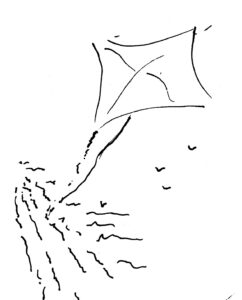walkingwiththunder.com
My kite
By Conrad Beaubien
It seems that the season we’re in prompts me to retrieve my kite from the bottom dresser drawer. I’ll set it to the wind to shed the dust and let it announce a time of spring renewal; head to open spaces where, depending on time of day, the wind and especially thermal drafts as I’ve learned, will lend the kite and I a hand.
Hot air balloons are seen flying mainly in early morning when the up and down drafts are in balance or then again when the air calms come evening, but I will wait for an afternoon on a sunny day when I happen to be free to play to launch my kite. It would seem that obvious places for wind are the lake shorelines, except most often the winds move off the lake and toward land and banks of trees that grow a few feet from water’s edge. The setup is bound to re-enact the old story of how kites and trees are non-compatible, so I choose an open field, fallow land with clear horizons, something we have plenty of all around.
 Vultures flying high have tutored me about thermal changes and updrafts that happen with the alchemy of sun, air and earth. The sun heats the earth and the air rises as the day lingers, generally a time when the large birds can be seen soaring effortlessly, circling and then circling again as their acute sense of smell tracks the skies like radar in search of the scent of carrion, the scent of decay of a dead creature as the whiff of it simultaneously rises from the earth. Vultures have been spotted by airline pilots as high as twenty thousand feet, and in my imagination I travel with the birds as they ride in the ethers.
Vultures flying high have tutored me about thermal changes and updrafts that happen with the alchemy of sun, air and earth. The sun heats the earth and the air rises as the day lingers, generally a time when the large birds can be seen soaring effortlessly, circling and then circling again as their acute sense of smell tracks the skies like radar in search of the scent of carrion, the scent of decay of a dead creature as the whiff of it simultaneously rises from the earth. Vultures have been spotted by airline pilots as high as twenty thousand feet, and in my imagination I travel with the birds as they ride in the ethers.
I was quite young, but I recall one day in our backyard when my mom showed me how to make a kite in the way she once did in the company of her brother. She told of how they’d shave strips of wood from weathered cedar rail fences, advantaging the dried cedar’s lightness, but on that particular day of kite-making, a couple of long and thin wooden rods from the hardware store would be the stand-in.
We cut a shallow notch into the tip of each rod that would hold a light cotton string in place; the string when pulled taught would become the surrounding outer support for the kite. I think it was red and green, the thin paper skin we attached to the string with glue, marrying the material to the filament forming the circumference. The tail was last to be attached, measuring it by my height of less than four feet at the time.
Then with a stick of wood to which was wound a length of string tethered to the kite, holding it firmly in my hand, with great expectation I ran for it, guiding my first kite above my head to help give it lift. The red and green complemented the blue sky as I watched my kite rise, safely out of reach of the tall elms that framed the backyard. That initial flight and time spent with my mom is a lasting memory; we congratulated ourselves on the accomplishment, and even though our kite components were less than robust and couldn’t hold up to sudden landings, that day I not only learned about the architecture of a kite and its requirements, but I experienced for the first time, the magic of surrendering every earthly care and allowing them to join my kite and follow it into open heavens.

Comments (0)